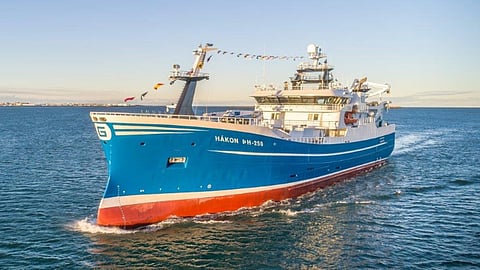VESSEL REVIEW | Hakon – Versatile purser/trawler for Icelandic pelagic fishing company
Danish shipbuilder Karstensens Skibsværft has handed over a new pelagic and demersal trawler to Icelandic fishing company Gjögur. The DNV-classed Hakon is also equipped for purse seining and will replace an earlier similarly named vessel that was completed for the same owner in 2001.
The vessel design, specification, and arrangements are a result of an extensive and close cooperation between the owner and the yard where all solutions are optimised and tailor-made to suit the owner’s and crews’ specific requirements.
The main focus has been set on optimising working, safety, and comfort for the crew; optimising catch handling and storage facilities; and optimising the fuel consumption. In order to satisfy these requirements, the vessel is fitted out with modern machinery and equipment.
Ample facilities for extended-duration fishing operations
The newer Hakon has an LOA of 75.4 metres (247 feet), a moulded beam of 16.5 metres (54.1 feet), a scantling draught of eight metres (26 feet), a depth of 8.75 metres (28.7 feet), and a gross tonnage of 3,179. The vessel's hull was built at Karstensens facilities in Poland and then transported to Denmark for completion.
The hull is built in steel with two continuous decks and with long forecastle and boat decks. The wheelhouse, the boat decks, the funnel, and the masts are built in aluminium. The hull shape is of round bilge construction with a bulbous bow, a stern skeg, a vertical wave-piercing stem, and a transom stern.
Below the main deck, the hull is subdivided into a forepeak; a sonar/thruster room; an insulated RSW tank section with 13 tanks and a central pump and manifold room; an engine room with the main engine connected to a reduction gearbox with one ducted propeller; and an aftpeak with fuel and lube oil tanks.
On the main deck are the forepeak, stores, the ozone plant room, the RSW hold/trunk section with central corridors, forward containing vacuum pump room, and a midship RSW machinery room.
The accommodation spaces on the main deck include two two-person and two officers’ cabins all with en-suite toilet/shower facilities, a laundry room, and a trim room. In order to create the best possible design for ensuring low noise levels, the accommodation is located as far away from the propeller as possible. In addition, a number of constructive steps have been made in order to generate low noise levels.
The shelter deck features the generator room, a roll damping tank, the RSW control room, and a centre deck house. Also on this deck are five single-person cabins with en suite toilets, a hospital, a coffee bar, a trawl workshop, and a changing room.
Comprehensive suite of deck equipment fore and aft
The two boat decks house four officer cabins, a welding shop, a stores area, a mess, a day room/lounge, a cinema, a hospital, and a galley with provisions space. These decks also feature the main deck crane, the fish pump and its dedicated crane, a purse net stacker crane, the purse seine and trawl winches, the trawl blocks, the reels, and the MOB boat, which is launched and recovered via a dedicated davit.
The winches, the cranes, and the fish pump are from SeaQuest Systems while Thyboron Trawldoor supplied the 12-metre (39-foot) battery-powered doors fitted with depth sensors and that can be controlled remotely from the wheelhouse. The freezing and catch handling equipment meanwhile includes two Cflow vacuum tanks and two FrioNordica 1,300kW RSW plants.
Efficient propulsion setup
Power for the vessel is provided by a 5,200kW (7,000hp) diesel engine driving a 4,000mm propeller to deliver a speed of just over 16 knots. Manoeuvring is aided by a steering system and a rudder from Kongsberg and three side thrusters from Brunvoll.
During heaving/shooting operations when fishing when the winch system is in use, the gearbox PTO will be clutched in, and electrical power will be supplied from the shaft alternator. When there is demand for full power on the winches, there will normally not be the same demand for power on the main engine. Following the main engine will be the power source for both propulsion and winch systems.
During normal towing, the shaft alternator can be disengaged from the switchboard, and the electrical power will be supplied by either of the two main generators. The generators will be able to connect into the main switchboard, controlled by the vessel’s DEIF power management system.
The propulsion system also has take-me-home capability by means of a clutch between the main engine and the gearbox. This allows the shaft alternator to work as an electric propulsion motor connected to the auxiliary generators.
Hakon also boasts an extensive array of electronics for navigation, communication, and fish finding. Among these are Hatteland displays, Simrad sonars and echosounders, JRC radars, a Furuno voyage data recorder, Sailor VHF radios, Starlink and Intellian satcoms, a Zenitel intercom, and plotters from Olex and MaxSea.
Hakon recently arrived in Reykjavik and has since departed on its first operational sailing.


